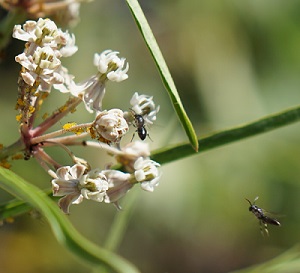Milkweed (Asclepias) is the primary host plant for Monarch butterfly caterpillars. Planting locally native milkweed in your garden will provide much needed habitat for these beautiful insects. There are fifteen species of milkweed that are native to California. The Nursery currently grows two of them. More information about California milkweeds is available from the Xerces Society.
Keep in mind that a single plant is usually not enough to provide habitat for butterflies, and providing multiple species of milkweed is better than one. In her book, The California Wildlife Habitat Garden, Nancy Bauer recommends including at least three plants of each species grown.
Asclepias fascicularis (Narrow-leaved Milkweed)
 As one might guess from its name, this milkweed has narrow leaves that grow up to five inches long. They are fairly tall plants, growing up to three feet tall with multiple stems topped with clusters of white and pink flowers from June through September.
As one might guess from its name, this milkweed has narrow leaves that grow up to five inches long. They are fairly tall plants, growing up to three feet tall with multiple stems topped with clusters of white and pink flowers from June through September.
This is the most adaptable of the California milkweeds, growing well in both sun and shade, and tolerating both clay and sand. They even do well under oaks and can be found under them in the wild. With their striking flowers and long blooming season, these are ideal plants for any garden.
They are perennials, but will die back to their roots in the fall. They reemerge from their deep taproot in the spring, putting out additional stems each year.
Although they are known for their relationship with the Monarch butterfly, their flowers are also popular with bees and other pollinators.
More information is available at Mother Nature's Backyard and Las Pilitas.
Asclepias speciosa (Showy Milkweed)
This milkweed is native to the Bay Area and northern California. It has wide fuzzy grey to white leaves and spectacular 4 to 5 inch pinkish-white flower heads. It can grow three or four feet tall, although it tends to grow slowly and may take a couple years to reach full height. It prefers full sun and does not need supplemental water once established.
Like narrow-leaved milkweed, it will die down to the roots in the fall. It usually emerges a bit later than narrow-leaved milkweed, so give it time to come up in late spring to early summer. The bloom period doesn't last as long - flowers tend to appear in June and July. However, the huge, gorgeous flowers more than make up for the shorter length of time.
More information about Showy Milkweed can be found on Calflora and Las Pilitas.

